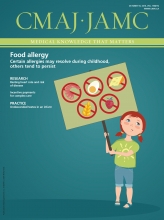Practice
Raynaud phenomenon causing lingual pallor and dysarthria
Soumya Chatterjee
CMAJ October 18, 2016 188 (15) E396; DOI: https://doi.org/10.1503/cmaj.150547
Soumya Chatterjee
Department of Rheumatic and Immunologic Diseases, Orthopaedic and Rheumatologic Institute, Cleveland Clinic, Cleveland, Ohio
MD MSIn this issue
Article tools
Respond to this article
Raynaud phenomenon causing lingual pallor and dysarthria
Soumya Chatterjee
CMAJ Oct 2016, 188 (15) E396; DOI: 10.1503/cmaj.150547
Related Articles
- No related articles found.











